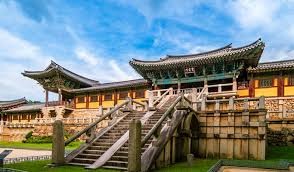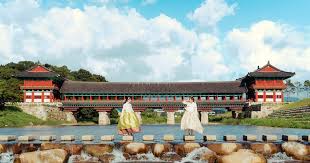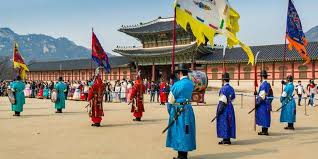Have you ever walked into a city and felt like you’d entered a time machine—with no buttons to push, just centuries of stories echoing from every corner? Picture this: I once tried to lead a group of jetlagged teachers through labyrinthine Gyeongju, fumbling with train tickets and Google Maps, only to realize the city’s greatest secrets reveal themselves when you stop worrying about what you’re missing and start soaking up what’s in front of you. Let’s unravel why this legendary ‘museum without walls’ is the unlikely star for groups seeking more than selfies—and how the right travel partner (not your clueless friend from college) makes all the difference.
Where Ancient Stones Outnumber Instagram Posts: Gyeongju Historical Sites
In Gyeongju, the echoes of the Silla Dynasty (57 BC – 935 AD) are found not in digital feeds, but in the enduring presence of ancient stones. This city, often called “the museum without walls,” is a living time capsule where UNESCO World Heritage Sites, royal tombs, and centuries-old observatories quietly outnumber the fleeting moments of social media. For those seeking a true Gyeongju Travel Guide, the city’s historical sites offer a journey through Korea’s golden age—one stone, tomb, and artifact at a time.
Bulguksa Temple and Seokguram Grotto: UNESCO Icons of the Silla Dynasty
At the heart of Gyeongju Historical Sites are Bulguksa Temple and Seokguram Grotto, two UNESCO World Heritage Sites that define the city’s spiritual and architectural legacy. Unlike typical tourist stops, these attractions come alive through expert-led tours by real historians and archaeologists. Visitors gain insights into the Silla Dynasty’s Buddhist culture, with stories that reveal why Bulguksa’s stone pagodas and intricate woodwork have survived for over a millennium.
Seokguram Grotto, perched on Mount Toham, houses a serene granite Buddha gazing eastward. Guided sunrise meditations and historical walks organized by Destination Management Companies (DMCs) allow groups to experience the grotto’s spiritual atmosphere, far beyond what any audio guide can offer. These curated experiences transform UNESCO World Heritage Sites into immersive classrooms, connecting visitors with Korea’s ancient wisdom.
Cheomseongdae Observatory: Stargazing with Silla Ingenuity
As dusk settles, a stroll through Gyeongju’s open fields can lead to a quiet encounter with Cheomseongdae Observatory. Built in the 7th century, this stone tower is the oldest surviving astronomical observatory in East Asia. Its 362 stones are said to represent the days of the lunar year, reflecting the Silla Dynasty’s advanced understanding of science and the cosmos. Stumbling upon Cheomseongdae at twilight, visitors find new meaning in ‘stargazing’—where ancient astronomers once observed the heavens, today’s travelers pause to reflect on the passage of time.
Tumuli Park: Where Kings Rest Beneath Lumpy Hills
Gyeongju’s landscape is dotted with grassy mounds that, at first glance, might seem like gentle hills. In truth, these are the royal tombs of the Silla kings, clustered in the Daereungwon Tomb Complex—also known as Tumuli Park. Here, the past is not hidden but rises from the earth in plain sight. The Cheonmachong Tomb, open to the public, allows visitors to step inside a burial chamber and see replicas of the gold crowns, horse trappings, and treasures that accompanied Silla royalty to the afterlife.
“If stones could talk, Gyeongju would never stop whispering.”—Park Jimin, Korean cultural historian
Guided walks through Tumuli Park, arranged by DMCs, reveal the symbolism behind each mound and the burial traditions that shaped Silla society. The lumpy hills become storytellers, sharing secrets of ancient power and belief.
Gyeongju National Museum: 80,000+ Artifacts of Silla Heritage
No Gyeongju Travel Guide is complete without a visit to the Gyeongju National Museum. Home to over 80,000 artifacts, this museum is a treasure trove of Silla Dynasty relics—gleaming gold crowns, intricately crafted jewelry, and ancient weapons. DMC-led private tours with museum curators offer groups a deeper understanding of the artistry and innovation that defined the era. Each exhibit connects the dots between the city’s scattered historical sites, weaving a cohesive narrative of Korea’s ancient capital.
Layered Narratives Across Gyeongju Attractions
Gyeongju’s historical sites are spread across a vast, walkable canvas. From the lantern-lit waters of Anapji Pond—once a royal pleasure garden—to the panoramic trails of Namsan Mountain dotted with Buddhist carvings, every site is a chapter in the city’s ongoing story. The integration of technology, such as geolocation tools and social sharing features, helps visitors navigate these layered narratives while preserving the authenticity of the experience.
In Gyeongju, ancient stones are more than relics—they are living witnesses to a civilization that shaped Korea’s identity. For group travelers, history enthusiasts, and cultural explorers, these sites offer an unmatched opportunity to step beyond the screen and into the heart of the Silla Dynasty.

Group Travel in Gyeongju: Why Going It Alone Feels Like a Silla-Era Marathon
Imagine arriving in Gyeongju, South Korea’s “museum without walls,” with a group of eager travelers—only to discover that the city’s treasures are scattered across hills, hidden behind ancient walls, and separated by winding roads with elusive bus stops. Add to that the absence of a direct international airport, and it’s easy to see why Gyeongju group travel can feel like a marathon worthy of the Silla Dynasty itself. For those planning a Gyeongju itinerary, the city’s historical depth is matched only by the logistical challenges of seeing it all. That’s where the superpowers of Destination Management Companies (DMCs) come into play, transforming potential chaos into seamless cultural discovery.
Navigating Gyeongju: More Than Just a Travel Guide
Unlike other Korean cities, Gyeongju’s attractions—from Bulguksa Temple to the royal tombs of Tumuli Park—are spread far and wide. Public transportation is reliable but not always intuitive, especially for large groups. The lack of a direct international airport means most visitors arrive via KTX high-speed trains from Seoul, Busan, or Incheon, followed by local transfers. Without expert help, even the most detailed Gyeongju travel guide can’t prevent mishaps—like the time half a group ended up at the wrong palace, until a DMC-supplied local expert waved everyone down with a hanbok and a grin.
The Superpowers of Destination Management Companies (DMCs)
DMCs are the unsung heroes of Gyeongju group travel. Their insider knowledge and logistical expertise turn what could be a Silla-era marathon into a smooth, immersive journey. Here’s how:
- Private and VIP Access: DMCs arrange exclusive, after-hours tours at UNESCO sites like Bulguksa Temple and Seokguram Grotto. Groups enjoy private guides—often historians or archaeologists—who provide stories and context that bring ancient Korea to life. As Min Seo, a local tour operator, puts it:
“Traveling with a great DMC is like finding a fast-forward button for cultural discovery.”
- Seamless Logistics: From booking KTX train tickets and charter buses to handling luggage and accommodations, DMCs manage every detail. This is especially important in a city where a missed transfer can mean missing out on a once-in-a-lifetime experience, like a sunrise meditation at Seokguram Grotto.
- Authentic Gyeongju Cultural Experiences: DMCs curate hands-on activities—think hanbok dress-up sessions, Korean calligraphy workshops, and private tea ceremonies in historic Hanok houses. These experiences go beyond sightseeing, allowing groups to participate in living Korean traditions.
- Distinctive Gyeongju Accommodations: Whether it’s a Hanok-style guesthouse, a luxury hotel with royal themes, or a temple stay at Golgulsa Temple, DMCs secure unique lodging that enhances the Gyeongju travel experience.
- VIP Festival and Event Participation: DMCs unlock priority seating at the Gyeongju Cherry Blossom Festival, exclusive access to Silla Cultural Festival parades, and even private nighttime tours of palaces and temples—ensuring groups avoid crowds and enjoy the best of Gyeongju’s vibrant celebrations.
Top Gyeongju Group Travel Experiences
- Bulguksa Temple: Guided tours and meditation sessions with monks in a UNESCO masterpiece.
- Seokguram Grotto: Sunrise hikes and spiritual explorations with expert narration.
- Tumuli Park: Step inside Cheonmachong Tomb and learn about Silla burial traditions.
- Anapji Pond: Lantern-lit tours with historical reenactments and music.
- Gyeongju National Museum: Curator-led tours of Silla gold crowns and ancient artifacts.
- Donggung Palace & Wolji Pond: Group photography and storytelling in royal settings.
- Gyeongju Tour Train: Panoramic city views and reserved group seating.
- Namsan Mountain: Group hiking trails among Buddhist carvings and pagodas.
- Traditional Silla-era Feast: Themed banquets with historical cuisine and performances.
- Golgulsa Temple: Live Sunmudo martial arts and meditation retreats.
Technology and Travel Services Integration
Modern Gyeongju travel platforms support user accounts, social media sharing, geolocation, and advanced search tools. These features make it easy for groups to find and book Gyeongju accommodations, luxury venues, and curated cultural experiences—ensuring every aspect of the journey is as efficient as it is enriching.
Beyond the Monuments: Crafting Your Own Silla Story Through Food and Festivals
While Gyeongju’s UNESCO sites and royal tombs are the city’s most photographed treasures, the true spirit of Korea’s ancient capital is best discovered through immersive Gyeongju Cultural Activities that invite visitors to step into the daily life, artistry, and flavors of the Silla Dynasty. For groups seeking more than a history lesson, Gyeongju offers a living canvas where every meal, festival, and hands-on workshop becomes part of your own Silla story.
One of the most memorable Gyeongju Cultural Experiences is the Silla-themed royal banquet. These feasts, curated by expert Destination Management Companies (DMCs), are more than just meals—they are edible time machines. Guests gather in Hanok-style banquet halls, surrounded by traditional décor, to sample dishes inspired by recipes once served to Silla royalty. The table might feature gyori gimbap (Gyeongju-style seaweed rice rolls), janchi guksu (celebration noodles), and delicate side dishes crafted from local produce. Each bite is a lesson in history, and while gold crowns are optional, stretchy pants are highly recommended. The experience is often enhanced by live performances of court music and dance, transporting participants to a time when food was both sustenance and spectacle.
Yet, Gyeongju’s living traditions extend far beyond the banquet table. For those eager to connect with the city’s artistic legacy, DMCs organize a variety of hands-on workshops that transform passive sightseeing into active participation. Pottery workshops, for example, allow visitors to get clay under their fingernails as they shape vessels inspired by Silla-era designs. Under the guidance of local artisans, groups learn not only the techniques but also the cultural significance behind each form and motif. As Kim Hyejin, a renowned cultural workshop instructor, puts it:
True cultural immersion starts when you pick up a paintbrush—or a pair of chopsticks.
Calligraphy sessions offer a similar window into the past, as participants learn to write ancient Hangeul characters with brush and ink, often in serene Hanok settings. For a more visual souvenir, hanbok dress-up experiences let visitors don royal costumes and pose for group photos against the backdrop of historic palaces or gardens. These activities, easily arranged by DMCs, are not only fun but also foster a deeper appreciation for the artistry and symbolism woven into Korea’s heritage.
No Gyeongju Travel Guide would be complete without mention of the city’s vibrant festival calendar, which brings history to life in spectacular fashion. The Gyeongju Cherry Blossom Festival is a highlight for group travel, drawing crowds eager to witness the city’s ancient streets and palace grounds transformed by clouds of pink blossoms. DMCs secure priority seating and the best vantage points, sparing groups the “feverish scramble” for the perfect view. As lanterns glow over Anapji Pond and traditional music fills the air, visitors experience firsthand how Gyeongju’s festivals blend the old and the new, making each year’s celebration unique.
Equally captivating is the Silla Cultural Festival, where parades, reenactments, and performances invite everyone to join in the pageantry of Korea’s golden age. Groups can participate in lantern-making, sample festival foods, and enjoy exclusive access to nighttime tours of historic sites—experiences that are both educational and unforgettable. For those seeking tranquility, Golgulsa Temple offers Sunmudo martial arts retreats and meditation sessions, blending physical discipline with spiritual reflection in a setting steeped in history.
These curated Gyeongju Cultural Activities—from royal banquets and pottery workshops to festival celebrations—demonstrate that authentic engagement with Korean tradition is not only possible but essential for meaningful group travel. With the expertise of a DMC, every detail is managed, allowing visitors to focus on discovery, connection, and the joy of crafting their own Silla story. In Gyeongju, history is not just observed—it is lived, tasted, and celebrated, ensuring that every group leaves with memories as rich and enduring as the city itself.
TL;DR: Gyeongju dazzles with living history, but group visits only work smoothly with expert planning—here’s how to trade confusion for culture, and missed turns for memories.

.jpeg)

.jpeg)